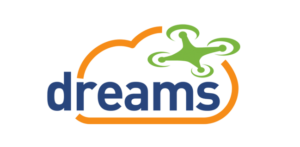
PROJECT: DREAMS – DRone European AIM Study
EU PROGRAMME: H2020-SESAR-2016-1
DURATION: 24 months| Oct. 2017 – Sept. 2019|
STATUS: closed
WEBSITE: https://www.u-spacedreams.eu/
CONTACTS: costantino.senatore@eurousc-italia
DREAMS (DRONE European AIM Study), is one of the various projects financed by the SESAR Joint Undertaking to start the development and future implementation of U-Space. The purpose of DREAMS is to define the operational concept of aeronautical information management for Remotely Piloted Aircraft Systems (UTM) at European level.
The project develops in 4 phases:
1. Selection of requirements for UTM information and services – collection of the needs of all UTM stakeholders and information from all relevant projects;
2. Regulatory and safety assessment of UTM information management (at a preliminary level) – which completes the previous point by taking into account aspects relating to safety and regulatory compliance;
3. Development of the operational concept of information management for the traffic of Remote Piloted Aircraft Systems (U-AIM CONOPS) – provides a reference model for the exchange of information in the UTM context;
4. Creation of the UTM validation platform – for testing the use of the information exchange model theorized in the previous point on a practical level.
The main objective of the DREAMS project is the development of a Safety Risk Assessment that allows the operators to determine a set of performances (transaction times, continuity and availability) and safety requirements (technical mitigation) that must be considered when planning drones operations. A regulatory compliance assessment was also conducted, focusing on defining the requirements for service providers in the U-Space and highlighting possible gaps with existing ICAO and European regulations (e.g. Regulation 373/2017, 73/2010).
The project also highlights the differences between traditional air navigation service providers (ANSP) for manned aircraft and U-space navigation service providers, proposing, in some cases, completely new definitions. There was also a need to adapt classic aeronautical concepts, such as “minimal weather” or “safe separation” to the specific characteristics of drones.
In any case, to demonstrate the compliance of U-Space service providers with the new requirements, the authorities could be supported by competent third parties (for example Qualified Entities) in the training or auditing processes. This need is even more significant in the context of U-Space where the risk level of most operations is high. The assignment of certification tasks to Qualified Entities also represents a means of reducing the burden on the authority.
OUR ROLE
The task assigned to EuroUSC Italia was to carry out a preliminary risk assessment of the scenarios identified in the U-Space context and to verify the regulatory compliance of these scenarios in which U-Space services are applied, in particular, as regards the technical aspects and those relating to service providers. The risk assessment was performed using the SORA (Specific Operations Risk Assessment) methodology and a classic approach based on the risk matrix. The latter was necessary to integrate SORA in the assessment of the risks in the air (in particular the possible interactions of several drones in the same area) and to perform an analysis of the malfunctioning conditions for the U-Space services.
THE CONSORTIUM
- Ingegneria Dei Sistemi S.p.A.
- TECHNISCHE UNIVERSITEIT DELFT
- EuroUSC-España, S.L.
- EuroUSC Italia
- TOP VIEW S.r.l
